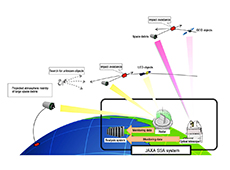
Keeping Spacecraft Safe from Debris
— What is the current state of space debris monitoring in Japan?
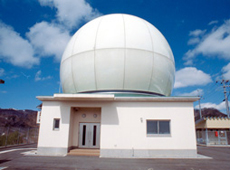 Kamisaibara Spaceguard Center
Kamisaibara Spaceguard Center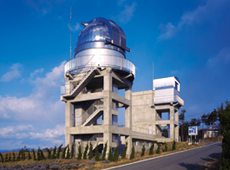 Bisei Spaceguard Center
Bisei Spaceguard Center
Space debris is monitored at the Kamisaibara Spaceguard Center and the Bisei Spaceguard Center, both in Okayama Prefecture. At Kamisaibara, we use radar to monitor debris in low Earth orbit (LEO) up to an altitude of approximately 2,000 km. Although the size of debris that can be monitored depends on its altitude, we can simultaneously track a total of 10 targets 1 meter or more in diameter. At Bisei, we use an optical telescope, which allows us to monitor debris in geostationary Earth orbit (GEO) at an altitude of 36,000 km.
JAXA analyzes data from these facilities to pinpoint debris orbit and position, and when this data and other inputs show that there is a possibility of debris colliding with satellites, a warning is issued to the satellite team. This is the role of the Space Tracking and Communications Center (STCC), where I work. To avoid being hit by debris, all you need to do is change your orbit, so the center prepares detailed proposals on when and how to do this. In some cases, debris is expected not to burn up on reentry into the atmosphere, but to fall back to Earth. In these situations, my job is to predict where it will reenter the atmosphere.
— Japan is only able to monitor space debris 1 meter or more in diameter. What happens with smaller pieces?
Radar monitoring facilities were brought online in Japan in 2004, when there was little understanding of the problem of space debris. At that time, we thought it was enough to be able to observe pieces of rocket bodies 1 meter or more in diameter as they reentered the atmosphere after carrying a satellite into orbit. But two things happened in the last decade that greatly increased the threat from space debris. First, in 2007, China carried out an experiment destroying one of its own satellites with a missile, and then, in 2009, an American and a Russian satellite collided. These incidents, which caused a sudden increase in the number of fragments, brought the problem of space debris to the attention of the global community.
In the United States, the Joint Space Operations Center (JSpOC) monitors space debris 24 hours a day, 365 days a year. Officially, JSpOC can detect debris 10 cm or more in diameter, and there is a mutual exchange of such information between JSpOC and JAXA. In cases where a Japanese satellite is threatened, JSpOC will send a warning. This arrangement is based on the Pact on Space Situational Awareness, which was signed by the U.S. and Japan in 2013.
Catastrophic Damage to Spacecraft
— Just how much space debris is there at the moment?
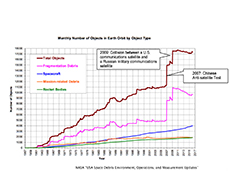 Orbital debris trends
Orbital debris trends

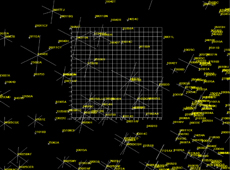 Monitoring screen for space debris observed from Earth (viewing angle ± 10°)
Monitoring screen for space debris observed from Earth (viewing angle ± 10°)

Space debris is not just spent rocket stages and end-of-life satellites, but also smaller fragments created when these items collide with each other. How much debris is actually up there? Well, since the former Soviet Union launched Sputnik 1 in 1957, the amount has been growing. As of now, JSpOC has documented more than 17,000 objects. But that’s not all. If you include objects smaller than 1 cm in diameter, which are difficult to monitor from Earth, there could be anywhere from tens of millions to 100 million. Most of these – 70-80% – are in low Earth orbit at an altitude of 2,000 km or less.
— How destructive is such debris if it hits a satellite?
Although the average velocity of debris in LEO is 7-8 km/s, satellites can be hit by debris traveling at relative speeds of 10-15 km/s, which has considerable destructive force. A bullet travels at a speed of several hundred meters per second, and debris can be moving at ten times that speed. So even debris as small as 1 cm in diameter can cause catastrophic damage to spacecraft.
— How frequently are warnings issued about space debris?
If a JAXA satellite is in danger of being hit by debris, JSpOC usually issues a warning one week in advance for satellites in LEO and two weeks in advance for satellites in GEO. The initial warning identifies approaching debris that could pose a threat in the general vicinity of the satellite in question. During the last fiscal year alone, we received about 90,000 such warnings. Once we get that warning, we monitor the fragment to see if it really is headed for the satellite. If there is a strong possibility that the satellite will be hit, then we prepare to change its orbit. This is not something that can be done quickly – it usually takes about two days of preparation. For satellites in LEO, we start working on this if the debris is likely to come within 1 km of the satellite, with a difference in altitude of about 200 m, and if there is a high probability of impact. This happens about 30 times a year. In the past year we have had to go through with changing the orbit of a satellite five times. Since this means taking a break from everything else the satellite is doing, such as monitoring the weather, for example, we only do it as a last resort.
— I’ve heard that the International Space Station had to change its orbit to avoid being hit by debris.
The ISS has Whipple bumpers, which can protect it from fragments up to 1 cm in diameter, but in some cases its orbit has had to be changed to avoid debris. With the ISS, NASA evaluates approaching debris and determines whether or not a change in orbit is required. When adjusting orbit, you have to temporarily stop the solar paddles from rotating, and pause any experiments that use a lot of power. Therefore, the decision to move is really left to the last possible moment. In June 2011, Japanese astronaut Satoshi Furukawa was one of six crew on the ISS who were forced to take shelter in two docked Soyuz spacecraft when a piece of space debris came uncomfortably close. This was because there wasn’t enough advance warning about the approaching fragment, and therefore no time to plan a debris avoidance maneuver. Although they were prepared to abandon the ISS in the unlikely event of a collision, the debris did not hit the ISS.
JAXA’s Contribution to Debris Monitoring
— Have any of JAXA’s satellites been hit by debris and destroyed?
Luckily, JAXA satellites have never suffered critical damage from space debris. So far we have managed to avoid large objects, and even if our satellites are hit by small objects, they still manage to stay operational thanks to features such as their protective shields. But since the danger from debris impact is growing year by year, we can’t afford to relax. We have to continue to monitor space debris 24 hours a day, 365 days a year. At present, our data is supplemented with support from overseas, but in future we plan to create a system that will enable us to monitor debris in the 10-cm class domestically.
— That will allow us to protect our own satellites, right?
Yes, that’s right. This way we won’t be relying on warnings from abroad, but will be able to collect and assess the information ourselves, and decide how to respond. At the very least, we need to be able to protect our own satellites independently. That’s why we at JAXA are planning to install a high-performance radar system at the Kamisaibara Spaceguard Center. We are aiming for 200 times the detection capability of the existing radar, so that we can monitor 10-cm-class objects. At the same time, since optical telescopes at our existing facility are performing well, we will simply continue to replace aging components, and JAXA will take over the responsibility for the monitoring of debris.
— What’s happening with international cooperation on space debris?
Space agencies in the United States and Europe also monitor debris, and there are discussions about sharing data among all of our institutions. With regard to GEO in particular, the sky over Japan can most accurately be monitored from Japan, for example, so it is feasible that we could work together by exchanging information. Space environmental problems need to be addressed on a global scale, so I think this kind of international cooperation is absolutely essential.
Improving the Accuracy of Debris Impact Prediction
— You were formerly the flight director for the H-II Transfer Vehicle (HTV), so you were the one receiving such information about debris, right?

Yes. After being launched from Tanegashima Space Center, the HTV gradually gains altitude as it approaches the ISS, but if it is threatened by debris, we change the scheduled orbit. In those days I wished that someone could provide more accurate information instead of just saying “it could be hit.” Just the mere thought needlessly sent my stress levels through the roof! Although it is possible to calculate the time and approximate size of the approaching debris, it is extremely difficult to predict whether or not it will actually collide with the HTV.
— Why is it so difficult to predict the impact of debris?
Because the density of the atmosphere influences the accuracy of debris impact prediction in low Earth orbit. We usually think of space as a vacuum, but in reality there are still traces of atmosphere at that altitude, so if density is high, then debris fragments encounter resistance, causing orbital decay. In that situation, the lower a fragment descends, the earlier it will arrive. And if the density of the atmosphere is lower than predicted, then the fragment will arrive later than expected. Of course we have atmospheric density models on which we base our calculations, but just as on Earth, actual atmospheric pressure patterns vary daily, depending on variables such as solar activity. So it’s all but impossible to perfectly predict the arrival time of an object a number of days in advance. I think the only way we could more accurately calculate the probability of debris impact is to improve the technology for predicting atmospheric density. That’s what we’re working on at JAXA.
— Finally, please tell us a little about your personal goals.
My short-term goal is to ensure that installation of the new debris monitoring system in Okayama Prefecture is completed on schedule, and that our debris tracking and monitoring capabilities are greatly enhanced. Until now, the kind of sophisticated debris monitoring system that is being developed by JAXA has not existed, so this is a new challenge. As an R&D institution, we feel that being able to help improve debris monitoring technology is extremely worthwhile.
In addition, I’d like to see us improve the accuracy of debris impact prediction. In weather forecasting, a circle is used to indicate the predicted course of a typhoon. Recently, a weather forecaster remarked that the size of that circle had become smaller. In other words, it seems that the accuracy of predicting the course of typhoons has increased. That’s exactly what we want to do: we want to make the circle indicating the predicted course of space debris, and the probability that it will collide with satellites, as small as possible.
Mayumi Matsuura

Space Situation Awareness (SSA) System Project Manager
JAXA Space Tracking and Communications Center (STCC)
After joining the National Space Development Agency of Japan (NASDA, now part of JAXA) in 1986, Ms. Matsuura initially worked in the Tracking and Control Center (now known as the Space Tracking and Communications Center). In 1992 she was transferred to the Range Operations Section of the Launch Control Department, and in 1998 joined the Space Environment Utilization Promotion Department (now the Human Space Technology Division), where she worked as flight director for the Japanese Kibo Module on the ISS and the HTV. In 2015, she was reassigned to the Flight Dynamics Team in the Space Tracking and Communications Center. In 2016 she was appointed project manager when the Space Situation Awareness (SSA) System project was established.
[ April 26, 2017 ]
- Preventing Collisions Between Debris and Spacecraft
- Harnessing the Power of the Private Sector to Clean Up Space Junk
- Global Efforts to Deal with the Problem of Space Debris
